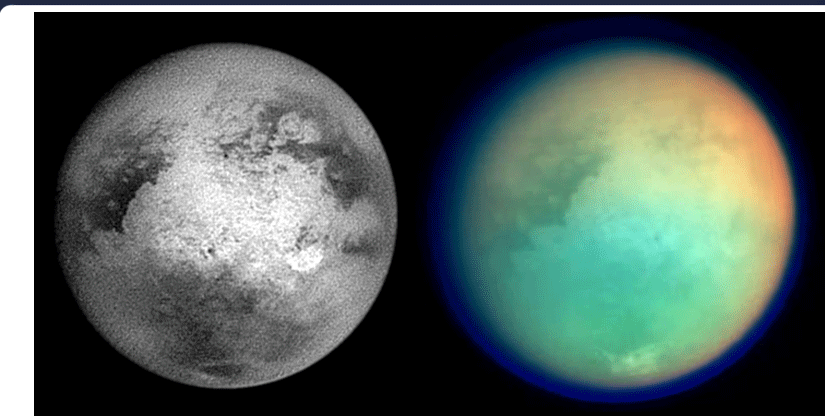Atmospheric Resonance on Saturn's Moon Titan
Titan's Odd Spot Baffles Scientists
NASA/ Jet Propulsion Laboratory
May 25, 2005
The recently discovered infrared-bright spot on Titan is the type of enigmatic feature that is best investigated by putting together as many different types of complementary information as possible. Cassini's varied array of scientific instruments is equal to the task...
The visual and infrared spectrometer team noted the bright region... after Cassini's March 31, 2004, Titan encounter. The strange, bright feature to the southeast of Xanadu was flagged as unusual and informally dubbed "The Smile" by imaging team members in December 2004. Together the images show that The Smile (seen by the imaging cameras at 0.938 micron) bounds the infrared "Bright, Red Spot" toward the southeast. The bright region seen in the visible and infrared mapping spectrometer image extends several hundred kilometers to the north and west of The Smile, but does not cover the dark terrain located between this area and Xanadu farther to the northwest. The Smile feature also seems to extend farther west at the south end than the Bright, Red Spot.
It seems clear that both instruments are detecting the same basic feature on Titan's surface. This bright patch may be due to an impact event, landslide, cryovolcanism, or atmospheric processes...
Analysis
Titan's enigmatic bright spot, and the many other cloud formations in Titan's atmosphere can indeed be explained by the structure of Magnetic Resonance presented above.
This comparative animation shows Cassini's visible light imaging of Titan at right and infrared imaging at left, being overlayed periodically by the quadrupolar Magnetic Resonance pattern (seen in gold at far left) to reveal the correlating symmetry of vortical points.
The nonlinear infrasound standing wave resonance on Titan is defining the relative positions of the eyes of the atmospheric storms which appear like stable hurricanes aligned in a latitudinal row, each vortex spinning in counter-rotation to adjacent storms.
The same resonance pattern also underlies the vortical storm activity on Jupiter, whose giant Red Spot was just joined by a smaller red companion vortex on April 8, 2006.
An identical comparison with the other gas planets reconfirms the correlation; in the ringed spectral shifts of Uranus and the concentric rings of heat distribution
observed in infrared imaging of Saturn, Titan's planetary partner.
This infrasound resonance pattern has also been observed for short periods on Earth and dictates the geopositions of the pyramids of the world, with the Orion pyramids of Giza, Egypt at the centerpoint.
The oncoming solar-system-wide magnetic reversal of December 22, 2012 may influence the atmospheric cloud patterns of Earth to become similar to those of Titan, with patterns of glowing plasma
forming in the skies - seen as brilliant luminous spots like standing aurora.





